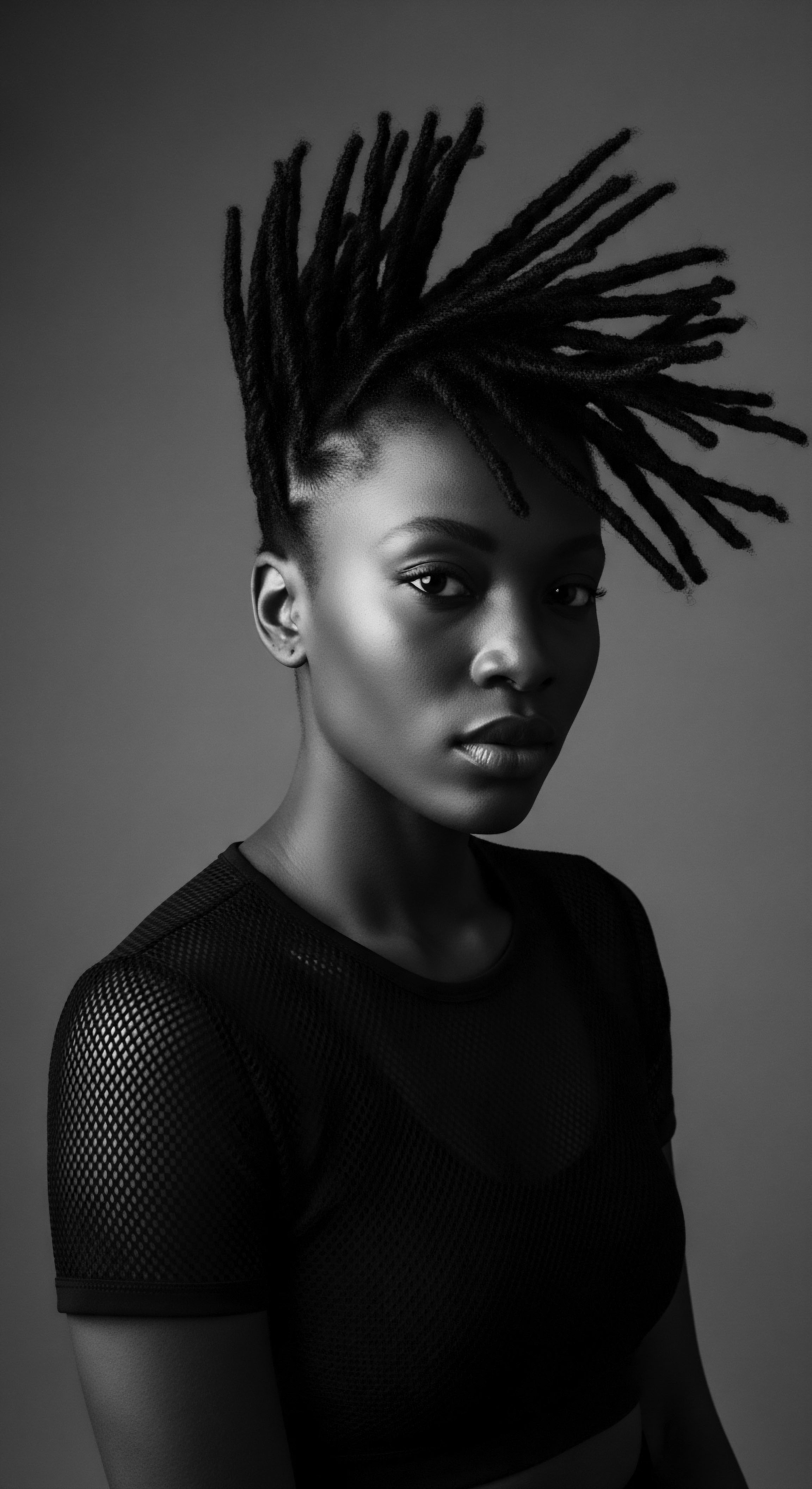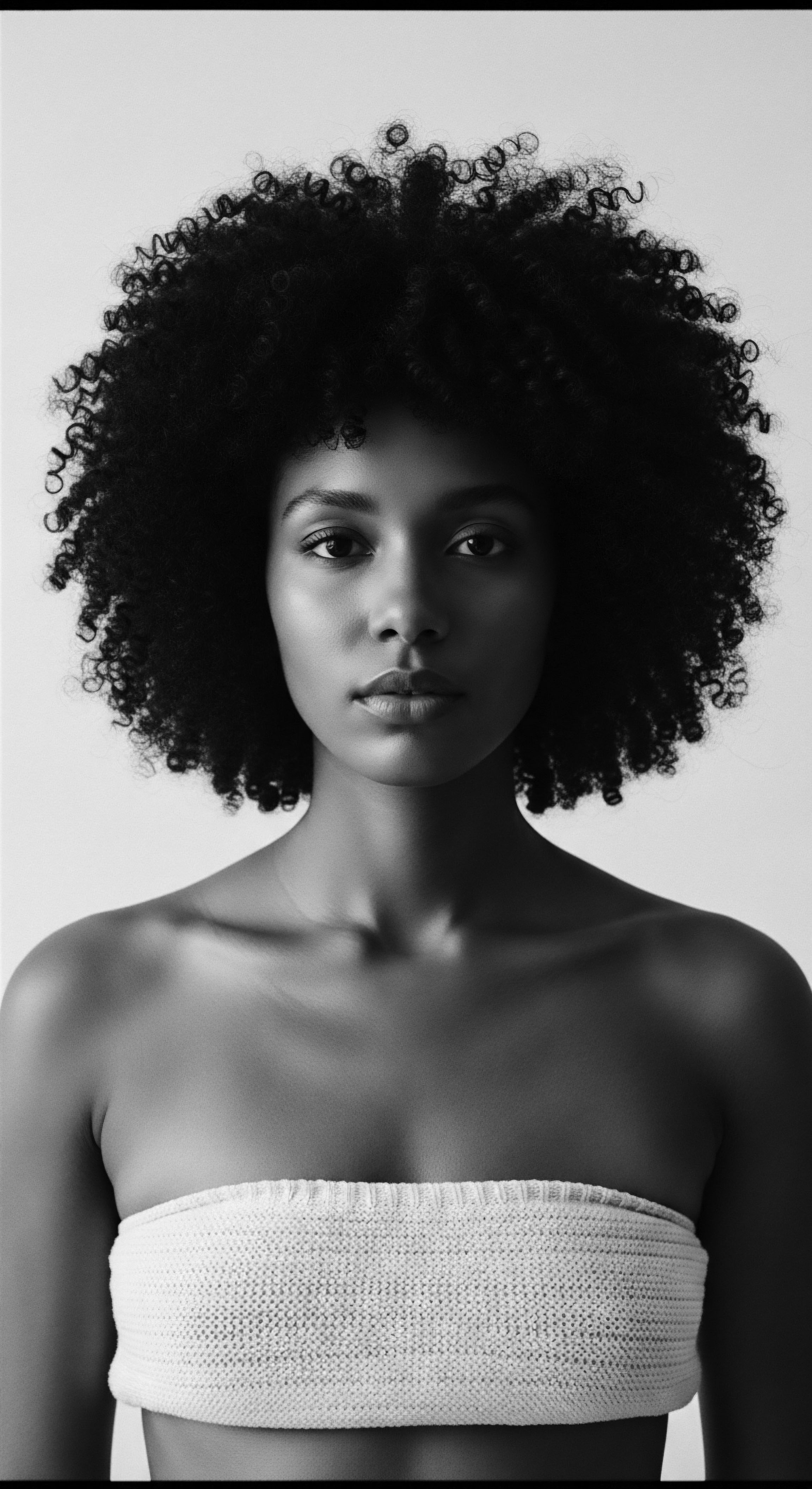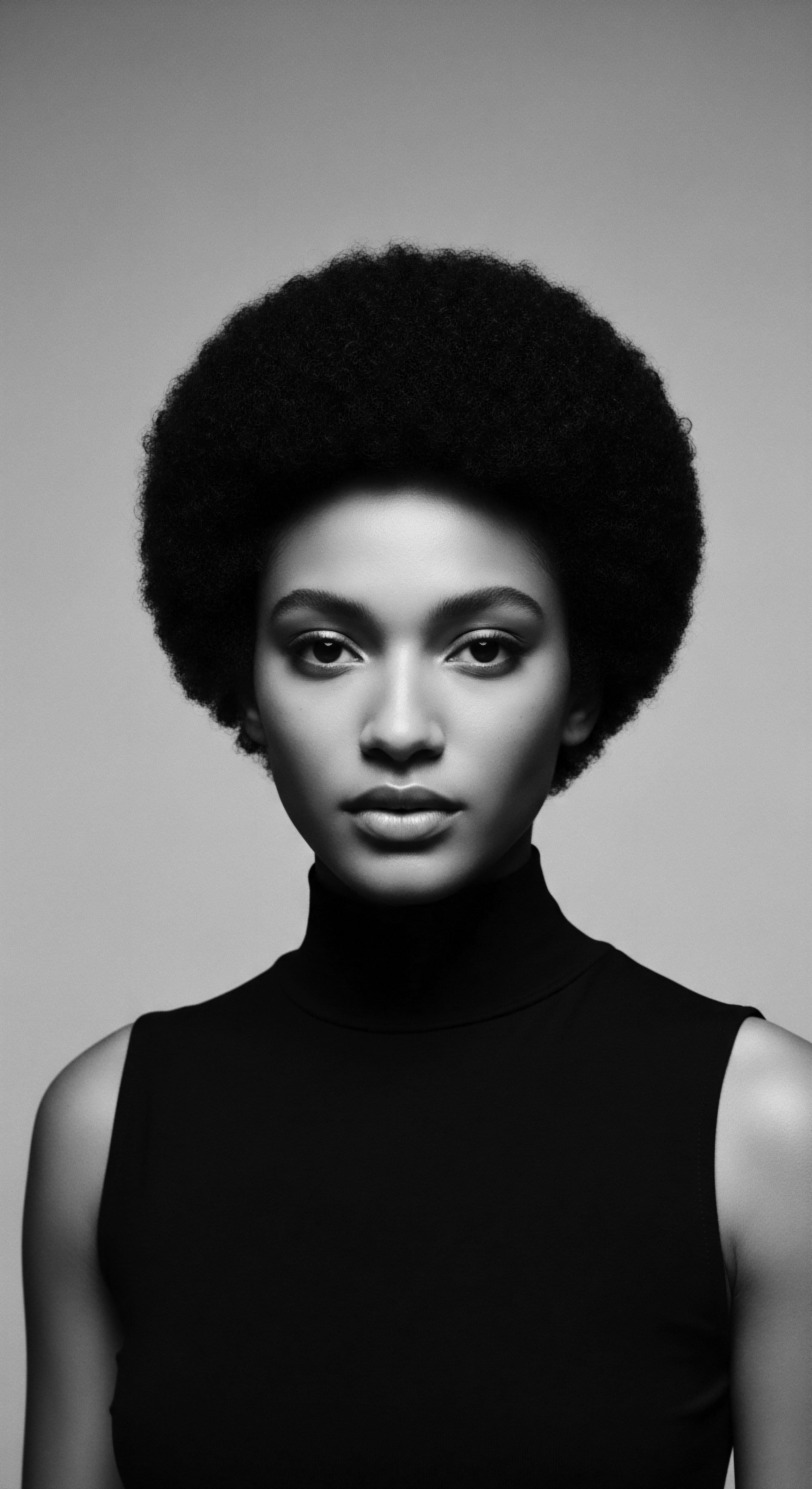
Roots
To walk the path of textured hair is to carry within one’s very being the echoes of countless generations, a living record of journeys spanning continents and centuries. Our coils, kinks, and waves are not merely fibers; they are ancestral conduits, repositories of stories whispered across time, often shaped by the sun, the wind, and the wisdom of those who came before us. Understanding which elements in the oils of our heritage offer a shield against light requires stepping into this deep stream, where ancient practices and contemporary molecular science meet, not in opposition, but in a quiet, affirming conversation.
The resilience of our hair, its inherent strength and distinctive beauty, has long been upheld by traditional care rituals. These practices, often dismissed by narratives that failed to acknowledge their intricate intelligence, were built upon an intimate knowledge of the land and its botanical offerings. Women and men of the diaspora, facing climates that demanded diligence, turned to the earth’s bounty, transforming seeds, fruits, and leaves into elixirs for protection and nourishment. This legacy, passed hand to hand, generation to generation, forms the bedrock of our inquiry.

The Hair’s Intrinsic Uniqueness
Textured hair possesses a singular architecture, a spiraling helix that dictates its volume, its form, and its unique relationship with external stressors. Unlike straighter strands, its elliptical cross-section and varied curl patterns influence how light interacts with its surface, how moisture is retained, and how external aggressors might affect its integrity. The cuticle layers, those delicate scales that form the hair’s outer shield, can be more prone to lifting at the curves and bends, potentially exposing the inner cortex to environmental onslaughts. This anatomical specificity is a key consideration when we speak of light protection; the need is not simply for a film, but for a symbiotic relationship between oil and strand.
Within the deeper structures of the hair shaft, particularly the cortex, lies a wealth of proteins, primarily keratins, along with lipids and melanin. Melanin, that magnificent pigment responsible for the hair’s spectrum of hues, does offer some inherent defense against ultraviolet exposure, yet it is not an impermeable barrier. Prolonged or intense light can still induce oxidative stress, leading to protein degradation, lipid peroxidation, and even alterations in the melanin itself, resulting in fading, brittleness, and a compromised tactile experience.
The profound wisdom of heritage hair care reveals an intuitive understanding of the hair’s needs, centuries before chemical structures were known.

What Does Heritage Oil Mean for Our Strands?
When we speak of “heritage oils,” we are referencing a specific lineage ❉ the plant-derived lipids deeply rooted in the ancestral care practices of Black and mixed-race communities. These are not merely moisturizing agents; they are historical artifacts, each carrying stories of cultivation, preparation, and application through generations. Consider the West African traditions of shea butter, the Caribbean reverence for castor oil, or the coconut oil preparations of coastal communities – each chosen for a spectrum of attributes, including, notably, protection from the elements.
The efficacy of these oils in shielding hair from light stems from their intricate molecular composition. They are not monolithic substances; rather, they are complex mixtures of fatty acids, vitamins, sterols, and an array of compounds often categorized as ‘unsaponifiable matter.’ It is within this rich, biological tapestry that the true protective mechanisms dwell. These molecular constituents, often in synergistic concert, interact with light, free radicals, and the hair’s own structure to maintain its vitality.
Understanding the protective functions of heritage oils means a patient study of their chemical blueprints. The fatty acid profiles, for example, influence the oil’s ability to penetrate the hair shaft versus coat its surface. Oils with a higher proportion of saturated fatty acids, like coconut oil’s lauric acid, have shown a capacity for deeper penetration into the hair’s cortex, potentially offering some internal fortification. Others, richer in monounsaturated or polyunsaturated fatty acids, might excel at forming a surface barrier, reducing direct light exposure and aiding in moisture retention, a crucial aspect of hair health under stress.
The journey into these molecular guardians begins with acknowledging the deep historical and cultural context that first elevated these oils to their cherished status in our ancestral hair rituals. We seek to honor that ancient discernment with the lens of modern understanding.

Ritual
The rituals of hair care, stretching back through time, were never solely about aesthetics. They were, and remain, acts of reverence, community building, and self-preservation. Within these cherished practices, heritage oils were applied with purpose, their textures and aromas becoming integral to a holistic approach to wellbeing. To understand the light-protective structures within them is to honor this deep, intertwined history of application and effect.

Which Molecular Structures Act as Light Barriers?
The light-filtering properties of many heritage oils are not attributable to a single compound but rather to a diverse collective of molecular entities. These compounds largely operate through two primary mechanisms ❉ absorbing specific wavelengths of light before they can reach the hair, or neutralizing the reactive oxygen species (free radicals) generated when light energy interacts with hair components. It is a dual defense, a testament to the ingenuity of natural chemistry.
- Polyphenols ❉ These vast classes of organic compounds, found abundantly in plants, are characterized by multiple phenolic hydroxyl groups. Their chemical structure allows them to absorb UV radiation and act as potent antioxidants. Oils like olive oil, traditionally used in Mediterranean and North African hair care practices, contain significant amounts of phenolic compounds. These molecules, including oleuropein and hydroxytyrosol, can intercept free radicals generated by light exposure, protecting the hair’s protein and lipid matrix from oxidative damage.
- Carotenoids ❉ These vibrant pigments, responsible for the yellows, oranges, and reds in many fruits and vegetables, are also present in some heritage oils, most notably red palm oil. Beta-carotene, a prominent carotenoid, is a well-documented quencher of singlet oxygen, a highly reactive form of oxygen produced under UV light. By neutralizing this destructive species, carotenoids mitigate light-induced degradation of hair proteins and lipids, helping to maintain structural integrity and color vibrancy.
- Tocopherols ❉ Commonly known as Vitamin E, tocopherols are a family of lipid-soluble antioxidants found in a wide range of heritage oils, including shea butter, sunflower seed oil, and argan oil. Alpha-tocopherol, the most biologically active form, is particularly adept at scavenging lipid peroxyl radicals, which are destructive byproducts of light-induced lipid oxidation in the hair. Their presence helps stabilize the hair’s lipid layers, preventing fragility and enhancing elasticity even under environmental stress.
Beyond these, other less abundant but equally significant molecules contribute to the protective shield. For instance, the unsaponifiable fraction of certain oils—the portion that doesn’t convert to soap when mixed with alkali—often harbors unique protective compounds. Shea butter, a cornerstone of West African hair care for generations, exemplifies this. Its unsaponifiable matter is rich in cinnamic acid esters and triterpene alcohols.
These structures possess inherent UV absorption capabilities, providing a form of natural sunscreen for the hair. Their historical and ongoing use in communities exposed to intense sun is a powerful validation of their efficacy (Maranz et al. 2004).

Does the Oil’s Fatty Acid Profile Matter?
While fatty acids themselves are not primary UV absorbers, their composition significantly influences the oil’s interaction with the hair and, by extension, its capacity to contribute to light protection. Saturated fatty acids, like the lauric acid in coconut oil, are smaller and straighter, allowing them to penetrate the hair shaft more readily, reaching the cortex. This internal presence can strengthen the hair from within, reducing protein loss and supporting its overall resilience against external stressors, including the indirect effects of light exposure.
Conversely, oils rich in unsaturated fatty acids, such as oleic acid (found in olive and argan oils) and linoleic acid (in sunflower or grape seed oil), tend to remain more on the hair’s surface. Here, they form a protective film that can reduce friction, minimize moisture loss, and provide a physical barrier against environmental assaults. While this barrier does not directly absorb UV rays in the same way as polyphenols or cinnamic acid esters, it creates a healthier, more intact cuticle, which is the first line of defense against light-induced damage.
The synergy of various molecular structures within heritage oils offers a multi-layered defense against the sun’s radiant touch.
The traditional practices of applying these oils, often through diligent massaging and regular reapplication, speak to an intuitive understanding of their long-term conditioning and protective benefits. It was a ritualistic acknowledgment that hair, much like skin, benefits from a consistent, natural shield against the elements.
| Heritage Oil Shea Butter |
| Key Molecular Protectors Cinnamic Acid Esters, Triterpene Alcohols, Tocopherols |
| Traditional Region/Use West Africa, for sun protection and deep conditioning |
| Heritage Oil Red Palm Oil |
| Key Molecular Protectors Carotenoids (Beta-carotene), Tocotrienols |
| Traditional Region/Use West/Central Africa, for nourishing and protective practices |
| Heritage Oil Coconut Oil |
| Key Molecular Protectors Lauric Acid (for internal strength), Tocopherols |
| Traditional Region/Use Coastal Africa, Caribbean, Pacific, for deep conditioning and luster |
| Heritage Oil Olive Oil |
| Key Molecular Protectors Polyphenols (Oleuropein, Hydroxytyrosol), Tocopherols |
| Traditional Region/Use Mediterranean, North Africa, for strength and sheen |
| Heritage Oil These oils, woven into the hair care practices of generations, exemplify the ancestral wisdom of botanical defenses. |
The continuity of these practices, often despite systemic challenges to their cultural prominence, underscores the deep-seated efficacy and profound cultural significance of these heritage oils. They are not merely commodities; they are cultural touchstones.

Relay
The journey of understanding the molecular structures in heritage oils that shield against light extends beyond simple identification; it demands a deeper engagement with the science that validates ancestral wisdom. The interplay of diverse compounds within these botanical extracts creates a defense that is often more complex and synergistic than the sum of its isolated parts. This profound interaction is what has allowed our heritage oils to protect and sustain textured hair through countless generations, even under the most challenging environmental conditions.

How Do Phenolic Compounds Guard Hair?
Phenolic compounds, an expansive group of phytochemicals, serve as remarkable guardians within heritage oils. Their protective prowess against light is rooted in their inherent ability to act as potent antioxidants and, in some cases, direct UV absorbers. Consider the polyphenols present in oils like olive oil (Olea europaea) or certain seed oils ❉ these molecules possess conjugated double bonds and aromatic rings, which are molecular motifs capable of absorbing specific wavelengths of ultraviolet radiation. This absorption mechanism dissipates the light energy, preventing it from reaching and damaging the hair’s keratin structure or melanin pigments.
Beyond direct UV absorption, their primary defensive strategy lies in their antioxidant capacity. When light energy, particularly UV-B and UV-A, strikes hair, it can generate reactive oxygen species (ROS), such as superoxide radicals, hydroxyl radicals, and singlet oxygen. These free radicals are highly destructive, initiating a cascade of oxidative damage that leads to protein degradation, lipid peroxidation, and alterations in melanin, resulting in changes like color fading, increased porosity, and reduced mechanical strength (Górska et al. 2008).
Phenolic compounds, with their electron-donating properties, can readily neutralize these free radicals, effectively quenching the oxidative chain reaction before it can inflict widespread harm. This is a critical aspect of how they protect hair from the long-term effects of light exposure, particularly relevant in regions with persistent, intense sun.

What Role Do Carotenoids Have in Light Protection?
The brilliant hues of red palm oil, a traditional staple across many West African communities, hint at its hidden defensive treasures ❉ the carotenoids. Beta-carotene, alpha-carotene, and lycopene are among the most prominent of these pigments. While less direct as UV filters compared to certain phenolics, their unparalleled strength lies in their ability to quench singlet oxygen.
Singlet oxygen is a particularly damaging form of ROS, capable of initiating extensive oxidative degradation within the hair shaft, especially to lipids and proteins (Foote, 1991). By effectively neutralizing singlet oxygen, carotenoids prevent this specific, highly destructive pathway of light-induced damage.
Furthermore, carotenoids contribute to the overall antioxidant network within the oil, working alongside tocopherols and other compounds. Their presence helps maintain the integrity of the hair’s lipid matrix, which is crucial for preserving moisture, elasticity, and the smooth alignment of cuticle scales. This comprehensive antioxidant defense ensures that hair remains fortified against the cumulative stress of daily light exposure, a silent yet persistent aggressor for many textured hair types.
The rich, historical application of shea butter in West Africa speaks to an inherent understanding of its solar safeguarding properties, now scientifically illuminated by its unique chemical structures.

How do Tocopherols and Unsaponifiables Protect Textured Hair?
Tocopherols, broadly known as Vitamin E, are a ubiquitous class of antioxidants found in many heritage oils, including shea butter and sunflower seed oil. They are lipid-soluble, meaning they can integrate into the hair’s lipid layers and effectively scavenge lipid peroxyl radicals. These radicals are generated when light initiates the breakdown of fats within the hair, leading to rancidity and structural compromise. By intercepting these destructive molecules, tocopherols stabilize the hair’s lipid content, preventing brittleness and maintaining suppleness (Traber & Atkinson, 2007).
The unsaponifiable matter of an oil, a fraction often rich in sterols, triterpenes, and other unique compounds, holds particular significance for heritage oils. Shea butter (Vitellaria paradoxa), a vital botanical resource throughout West Africa, stands as a premier example. Its unsaponifiable portion, comprising a notable percentage of the total oil, contains a high concentration of cinnamic acid esters and triterpene alcohols (Akihisa et al. 2010).
These specific molecular structures are pivotal in providing direct UV absorption. Cinnamic acid, in particular, possesses a chromophore that efficiently absorbs UV-B radiation, effectively acting as a natural sunscreen for the hair. This inherent photoprotective quality aligns directly with centuries of traditional use by West African communities who applied shea butter to protect both skin and hair from the harsh equatorial sun (Maranz et al. 2004). This deep heritage practice showcases how ancient communities intuitively understood the protective attributes of their botanical resources long before modern scientific elucidation.
The traditional uses of these oils, applied diligently by hand, often under the very sun they sought to mitigate, are compelling testaments to their efficacy. These are not just anecdotes; they are deeply ingrained cultural practices now receiving validation from the molecular realm. The enduring vibrancy and resilience of textured hair nurtured through these ancestral methods serve as living proof of the protective wisdom embedded within these heritage oils.

Reflection
To contemplate the molecular structures within heritage oils that shield against light is to stand at a profound intersection ❉ where the enduring legacy of ancestral wisdom meets the illuminating gaze of contemporary science. It is a dialogue that reaffirms the deep intelligence held within traditional hair care practices, revealing how our forebears, through centuries of keen observation and careful application, instinctively understood the intricate chemistry of the earth’s bounty. The oils, passed down through generations, are not merely cosmetic; they are protective balms, coded with the very molecular blueprints that defy the sun’s harsh kiss.
Our coils, our kinks, our waves carry stories of resilience, of beauty forged in adverse conditions, of identity expressed through every strand. The knowledge of these natural shields—the polyphenols, carotenoids, tocopherols, and unique esters—allows us to honor the past with newfound clarity, to recognize the profound purpose behind every ritual, every application. This understanding becomes another strand in the Soul of a Strand, reinforcing our collective heritage, a vibrant, living archive that continues to grow, ever more deeply rooted, ever more luminously aware of its own magnificent history and profound capacity.

References
- Akihisa, T. Kojima, N. Kikuchi, T. Yasukawa, K. Matsumoto, T. & Nikaido, T. (2010). Triterpene Cinnamates and Acetates from Shea Butter. Lipids, 45(2), 177–187.
- Foote, C. S. (1991). Definition of type I and type II photochemical processes. Photochemistry and Photobiology, 54(5), 659.
- Górska, A. Piksa, M. Golińska, B. & Gomułka, K. (2008). Antioxidant activity of various plant extracts against oxidative stress in hair. Journal of Cosmetic Science, 59(6), 461-470.
- Maranz, S. Wiesman, Z. Biskin, S. & Garti, N. (2004). Phenolic constituents of shea (Vitellaria paradoxa) kernels and their biological activities. Journal of Agricultural and Food Chemistry, 52(23), 7111–7116.
- Traber, M. G. & Atkinson, J. (2007). Vitamin E, antioxidant and nothing more. Free Radical Biology and Medicine, 43(1), 4–15.
